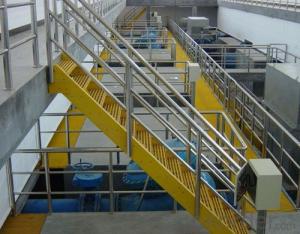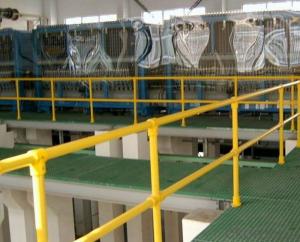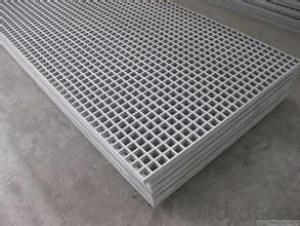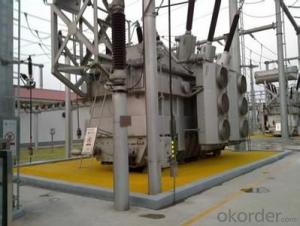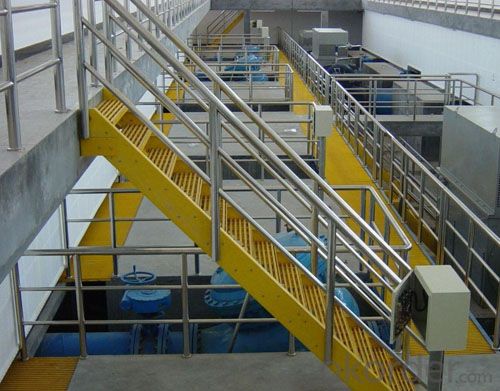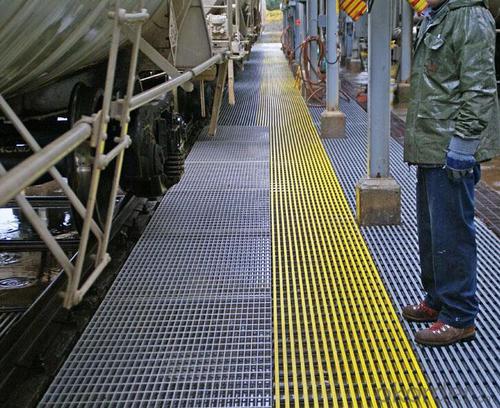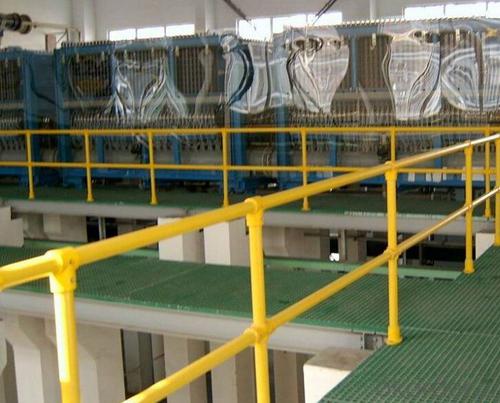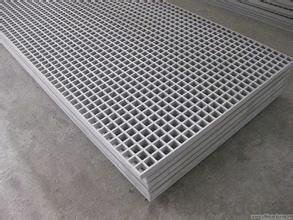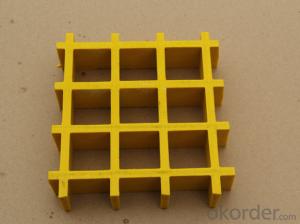FRP Pultrusion Profiles for Power Steel Paper Plant Grating Floor Insulation
- Loading Port:
- Shanghai
- Payment Terms:
- TT OR LC
- Min Order Qty:
- 10 pc
- Supply Capability:
- 8000 pc/month
OKorder Service Pledge
OKorder Financial Service
You Might Also Like
Specification:
FRP molded grating made of vertical and horizontal continuous fiberglass fully soaked in unsaturated polyester resin giving perfect bi-directional mechanical properties. Combining unmatched corrosion resistance with strength, long life and safety, molded grating provide the ultimate in reliable performance, even in the most demanding corrosive conditions. Besides, it is easy to cut and install. CNBM offer the widest selection with panel sizes, colors and slip resistant surfaces, clients can avail FRP grating your specific requirements.
Product Features:
- Light but high loaded strength
- High anti-corrosion and anti-aging
- Easy installation and maintenance
- Low maintenance
- Non-conductive
- Lowest in life cycle cost
- Corrosion Resstance
- Anti-slippery
- Various sizes and color available
Colour Design:
To satisfy customer's design project, CNBM grating offers a wide selection of grating colors to choose from. The standard colors available for fiberglass grating as following:
- Blue
- Red
- Yellow
- Green
- Light Grey
- Dark Grey
Custom colors of fiberglass grating may be available upon request, you can contact us learn more.
Moded Grating Sizes List:
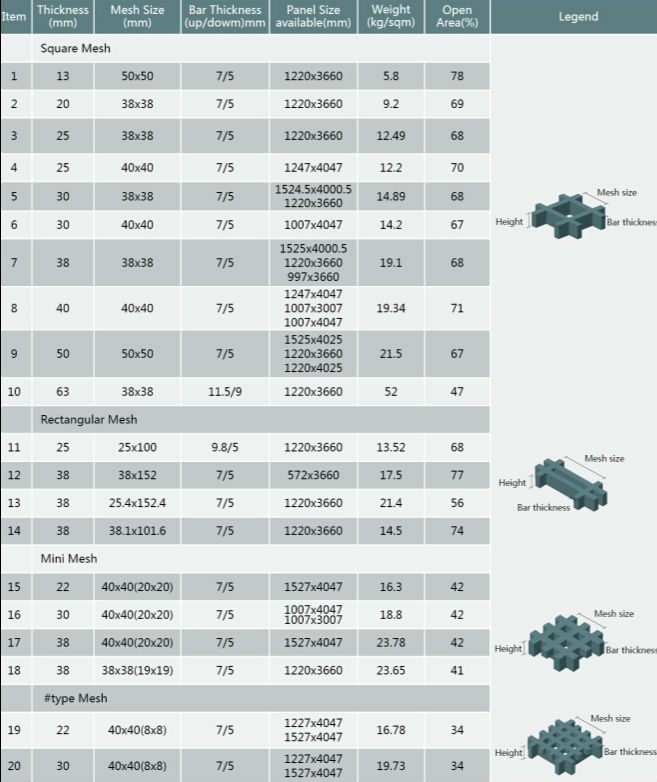
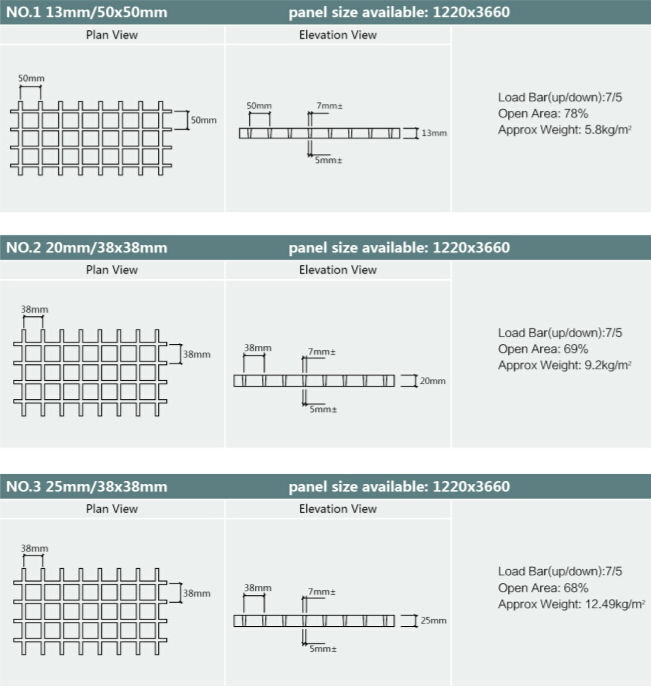

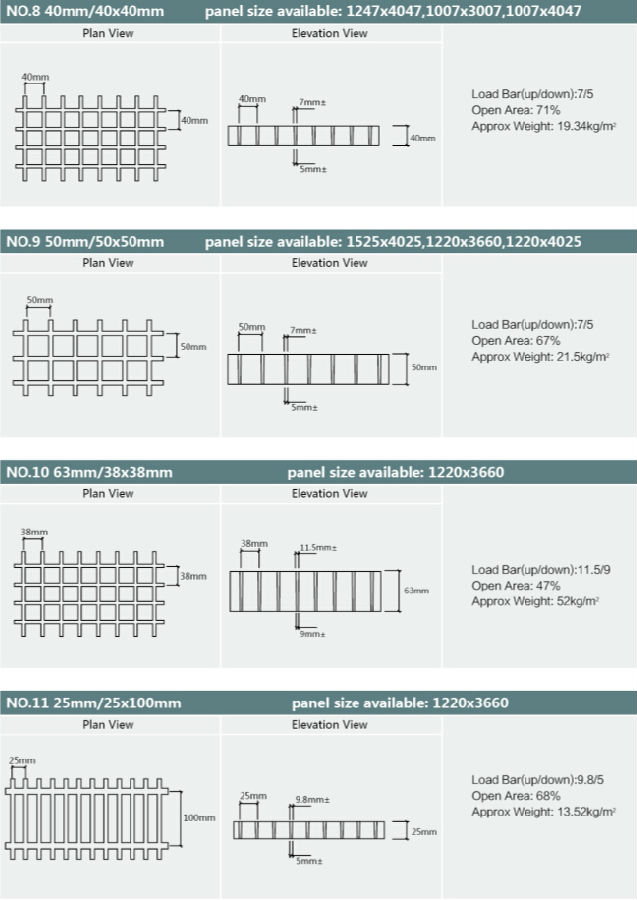
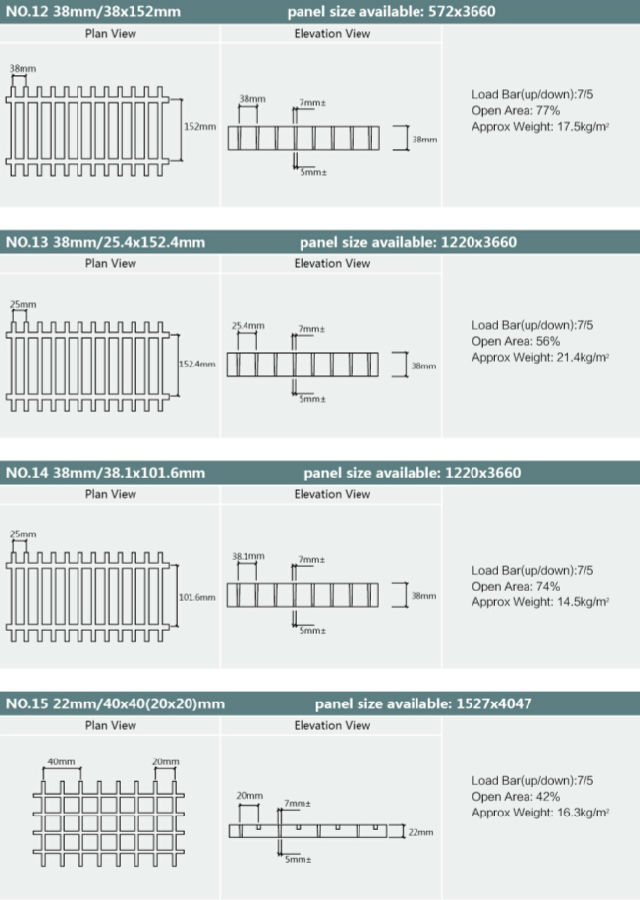

- Q: What does M23 grade of glass fiber reinforced plastic section mean?
- There are many kinds of FRP Pultruded Shapes, such as glass fiber reinforced plastic round tube, glass fiber reinforced plastic square tube, glass fiber reinforced plastic rectangular tube, glass fiber reinforced plastic round bar, glass fiber reinforced plastic i-beam.
- Q: Can FRP pultrusion profiles be used in the construction of water treatment plants?
- Yes, FRP (Fiber Reinforced Polymer) pultrusion profiles can be used in the construction of water treatment plants. FRP pultrusion profiles offer several advantages such as high strength-to-weight ratio, corrosion resistance, and durability, making them well-suited for water treatment plant applications. These profiles can be used in various structural components like beams, columns, grating, and handrails, providing a cost-effective and long-lasting solution for the construction of water treatment plants.
- Q: Can FRP pultrusion profiles be used in chemical storage tanks?
- Yes, FRP (Fiber Reinforced Polymer) pultrusion profiles can be used in chemical storage tanks. FRP pultrusion profiles are known for their excellent corrosion resistance, making them suitable for storing a wide range of chemicals. They are also lightweight, strong, and have a high strength-to-weight ratio, which makes them an ideal choice for constructing durable and long-lasting chemical storage tanks. Additionally, FRP pultrusion profiles can be customized to meet specific design requirements, allowing for flexibility in tank design and construction. Overall, FRP pultrusion profiles are a reliable and cost-effective option for chemical storage tanks due to their corrosion resistance, strength, and customization capabilities.
- Q: How do FRP pultrusion profiles perform in high-wind areas?
- Due to their exceptional performance characteristics, FRP pultrusion profiles are highly suitable for use in high-wind areas. These profiles utilize a combination of continuous glass fibers and a polymer resin matrix, resulting in a material that is both lightweight and incredibly strong and durable. One major advantage of FRP pultrusion profiles in high-wind areas is their excellent resistance to corrosion. Unlike traditional materials like steel or wood, FRP does not rust or rot when exposed to moisture or harsh weather conditions. This makes them ideal for regions prone to hurricanes or coastal environments where wind-driven saltwater or heavy rain can cause accelerated deterioration in other materials. In addition, FRP pultrusion profiles have a high strength-to-weight ratio, allowing them to withstand high wind loads without adding excessive weight to structures. Their lightweight nature makes transportation and installation easy, reducing overall costs and construction time in high-wind areas. Furthermore, FRP pultrusion profiles exhibit excellent dimensional stability, meaning they resist warping or deforming under extreme wind pressures. This stability ensures that structures utilizing FRP profiles maintain their integrity and functionality even in the face of strong winds. Moreover, FRP pultrusion profiles can be customized to meet specific wind load requirements. They can be engineered to have specific flexural or tensile strengths, allowing for tailored solutions to suit the demands of high-wind areas. Overall, FRP pultrusion profiles are an excellent choice for structures in high-wind areas due to their corrosion resistance, high strength-to-weight ratio, dimensional stability, and customization capabilities. These profiles provide a reliable, long-lasting, and cost-effective solution for structures exposed to intense wind loads, ensuring the safety and durability of the built environment.
- Q: Can FRP pultrusion profiles be used in water treatment plants?
- Yes, FRP (Fiber Reinforced Polymer) pultrusion profiles can be used in water treatment plants. FRP pultrusion profiles offer several advantages that make them well-suited for use in this industry. Firstly, FRP pultrusion profiles are highly corrosion resistant. Water treatment plants often have aggressive environments with exposure to chemicals and moisture, which can cause corrosion and degradation of traditional materials like steel. However, FRP pultrusion profiles are immune to corrosion, making them an ideal choice for water treatment applications. Secondly, FRP pultrusion profiles have excellent strength-to-weight ratios. This means that they provide high structural integrity while being lightweight, making them easier to handle and install in water treatment plants. Additionally, their high strength allows them to withstand the loads and pressures typically encountered in these environments. Furthermore, FRP pultrusion profiles are electrically non-conductive. This is particularly advantageous in water treatment plants, where there may be a need to isolate electrical equipment or components to prevent short circuits and protect personnel. FRP profiles provide a safe and reliable solution in such cases. Lastly, FRP pultrusion profiles have a long service life with minimal maintenance requirements. They do not rot, rust, or corrode, ensuring durability and longevity even in harsh water treatment conditions. This reduces downtime and maintenance costs, making FRP profiles a cost-effective choice for water treatment plant applications. Overall, FRP pultrusion profiles are an excellent choice for use in water treatment plants due to their corrosion resistance, high strength-to-weight ratio, electrical non-conductivity, and long service life. Their use can contribute to improved efficiency, reduced maintenance, and increased durability in water treatment processes.
- Q: Are FRP pultrusion profiles resistant to UV degradation?
- FRP pultrusion profiles typically possess strong resistance against UV degradation. These profiles, constructed from a blend of resin and glass fibers, are designed to endure extended sun exposure. The resin utilized in their production is customarily engineered to provide UV radiation resistance. This resistance effectively safeguards the FRP pultrusion profiles from the detrimental effects of prolonged sunlight exposure. Extensive testing has confirmed the exceptional UV resistance of FRP pultrusion profiles. Consequently, they are frequently employed in outdoor settings, such as construction, infrastructure, and marine industries, where they are subject to sunlight exposure. The UV resistance guarantees that these profiles maintain their structural integrity, color, and aesthetic appeal over an extended period. However, it is crucial to acknowledge that the level of UV resistance may differ based on the specific resin formulation used during manufacturing. Various manufacturers employ different resins containing varying levels of UV stabilizers. It is advisable to consult the manufacturer or supplier to ensure that the chosen FRP pultrusion profiles are specifically designed to withstand the UV conditions of the intended application. Regular maintenance and periodic inspection of the FRP pultrusion profiles are also vital to ensure their long-term UV resistance. This may involve cleaning, applying protective coatings, or utilizing UV-blocking additives if necessary. By taking these precautions, the UV resistance of FRP pultrusion profiles can be further enhanced, securing their durability and longevity in outdoor environments.
- Q: How do FRP pultrusion profiles perform in extreme cold temperatures?
- Due to the properties of the materials used, FRP pultrusion profiles perform exceptionally well in extremely cold temperatures. These profiles, made of FRP composites, are known for their excellent thermal insulation properties, which help maintain their structural integrity even in low temperatures. One major advantage of FRP pultrusion profiles in cold environments is their ability to resist freezing and thawing cycles. Unlike other materials, FRP does not absorb water, thus preventing expansion or contraction with temperature changes. This eliminates the risk of cracking or damage that can occur when moisture freezes and expands within traditional materials like metal or concrete. Moreover, FRP pultrusion profiles have a low coefficient of thermal expansion, meaning they do not significantly expand or contract with temperature fluctuations. This stability allows them to maintain their shape and structural integrity in extreme cold, reducing the chances of deformation or failure. Aside from their thermal properties, FRP pultrusion profiles also exhibit high strength and durability, making them suitable for various applications in construction, infrastructure, and transportation, even in harsh cold environments. They are resistant to corrosion, chemicals, and UV radiation, further enhancing their performance and longevity in extreme conditions. In conclusion, FRP pultrusion profiles are an excellent choice for applications requiring reliable performance in extreme cold temperatures. With their thermal insulation properties, resistance to freezing and thawing cycles, low coefficient of thermal expansion, and overall strength and durability, they are well-suited for various industries and environments, ensuring their continued performance even in the harshest cold conditions.
- Q: Are pultruded FRP sections strong? What are its main areas of application?
- General and environmental units of manhole covers, factories and mines units of insulated cable tray; chemical units of the transmission pipeline; insulation protection fence; including floor and so on.
- Q: Do FRP pultrusion profiles have any limitations or drawbacks?
- Yes, FRP pultrusion profiles do have certain limitations and drawbacks. One limitation is that FRP pultrusion profiles have lower stiffness compared to traditional materials like steel or aluminum. This means that they may not be suitable for applications that require high structural rigidity or heavy loads. Another limitation is that FRP pultrusion profiles are prone to creep, which is the gradual deformation of the material under a constant load over time. This can negatively affect the long-term performance and durability of the profiles, especially in applications where they are subjected to sustained stress. Additionally, FRP pultrusion profiles are generally more expensive to produce compared to traditional materials. The manufacturing process involves pultruding continuous fibers through a resin matrix, which requires specialized equipment and expertise. This can result in higher production costs, making FRP pultrusion profiles less cost-effective for certain applications. Furthermore, FRP pultrusion profiles are generally not suitable for high-temperature applications. The resin matrix used in their production can degrade or soften at elevated temperatures, limiting their use in environments where thermal resistance is critical. Lastly, FRP pultrusion profiles may have limited design flexibility compared to other materials. The pultrusion process typically produces profiles with constant cross-sections and limited geometric complexity. This can restrict their use in applications that require intricate shapes or customized designs. Despite these limitations and drawbacks, FRP pultrusion profiles offer several advantages such as high strength-to-weight ratio, corrosion resistance, and electrical insulation properties. It is important to carefully consider the specific requirements of the application before opting for FRP pultrusion profiles.
- Q: Can FRP pultrusion profiles be used in electrical insulation applications?
- FRP pultrusion profiles are capable of being utilized in electrical insulation applications. They possess exceptional electrical insulation properties, rendering them appropriate for a broad range of electrical applications. The superior dielectric strength of FRP materials ensures the efficient containment of electrical currents within designated pathways, thus preventing leakage and electrical hazards. Moreover, FRP profiles exhibit low electrical conductivity, thereby decreasing the likelihood of electrical shorts and enhancing overall safety in electrical insulation applications. The non-magnetic characteristics of FRP materials are also advantageous as they eliminate the potential for electromagnetic interference (EMI) in sensitive electrical systems. Furthermore, FRP pultrusion profiles are lightweight, resistant to corrosion, and boast a lengthy operational lifespan. This renders them an economical and robust solution for electrical insulation applications.
Send your message to us
FRP Pultrusion Profiles for Power Steel Paper Plant Grating Floor Insulation
- Loading Port:
- Shanghai
- Payment Terms:
- TT OR LC
- Min Order Qty:
- 10 pc
- Supply Capability:
- 8000 pc/month
OKorder Service Pledge
OKorder Financial Service
Similar products
Hot products
Hot Searches
Related keywords
